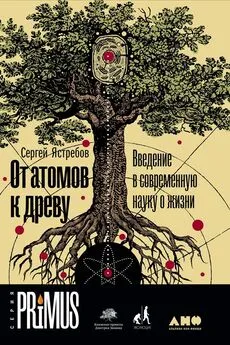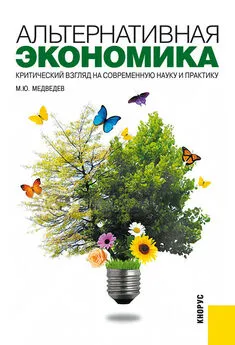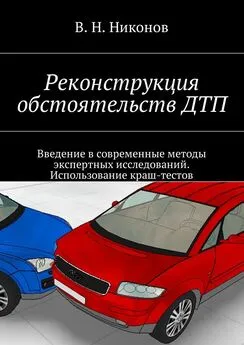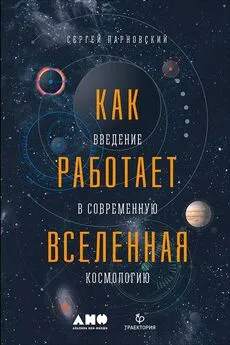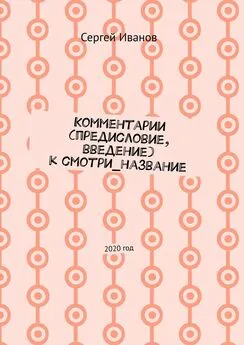Сергей Ястребов - От атомов к древу. Введение в современную науку о жизни
- Название:От атомов к древу. Введение в современную науку о жизни
- Автор:
- Жанр:
- Издательство:Альпина нон-фикшн
- Год:2018
- Город:Москва
- ISBN:978-5-9614-5286-0
- Рейтинг:
- Избранное:Добавить в избранное
-
Отзывы:
-
Ваша оценка:
Сергей Ястребов - От атомов к древу. Введение в современную науку о жизни краткое содержание
Рекомендуется широкому кругу читателей, всерьез интересующихся современной биологией.
От атомов к древу. Введение в современную науку о жизни - читать онлайн бесплатно ознакомительный отрывок
Интервал:
Закладка:
Cavalier-Smith , 2013a.
369
Keeling P. J. Diversity and evolutionary history of plastids and their hosts // American Journal of Botany , 2004, V. 91, № 10, 1481–1493.
370
Burki F. The eukaryotic tree of life from a global phylogenomic perspective // Cold Spring Harbor. Perspectives in Biology , 2014, V. 6, № 5, a016147.
371
Adl et al. , 2012.
372
Burki F., Shalchian-Tabrizi K., Pawlowski J. Phylogenomics reveals a new ‘megagroup’ including most photosynthetic eukaryotes // Biology Letters , 2008, V. 4, № 4, 366–369.
373
Hampl et al. , 2009.
374
Adl et al. , 2012.
375
Germot A., Philippe H. Critical analysis of eukaryotic phylogeny: a case study based on the HSP70 family // Journal of Eukaryotic Microbiology , 1999, V. 46, № 2, 116–124.
376
Germot, Philippe , 1999.
377
Philippe H., Germot A., Moreira D. The new phylogeny of eukaryotes // Current Opinion in Genetics & Development , 2000, V. 10, № 6, 596–601.
378
Philippe H. Early — branching or fast — evolving eukaryotes? An answer based on slowly evolving positions // Proceedings of the Royal Society of London, B: Biological Sciences , 2000, V. 267, № 1449, 1213–1221.
379
Philippe , 2000.
380
Philippe et al. , 2000. «Примитивность» — двусмысленный термин. В данном случае Эрве Филипп называет примитивностью раннее отхождение группы от общего ствола (а не простоту организации или сходство с общим предком — такие значения термина «примитивность» тоже существуют, но здесь они неактуальны).
381
Baldauf , 2003.
382
Завадский К. М., Колчинский Э. И. Эволюция эволюции. — Л.: Наука, 1977.
383
Simpson G. G. Periodicity in vertebrate evolution // Journal of Paleontology , 1952, V. 26, № 3, 359–370.
384
Colbert E. H. Explosive evolution // Evolution , 1953, V. 7, № 1, 89–90.
385
Chaline J. Rodents, evolution, and prehistory // Endeavour , 1977, V. 1, № 2, 44–51.
386
Rokas A., Carroll S. B. Bushes in the tree of life // PLoS Biology , 2006, V. 4, № 11, e352.
387
Pawlowski J. The new micro-kingdoms of eukaryotes // BMC Biology , 2013, V. 11, № 1, 40.
388
Walker G., Dacks J. B., Martin Embley T. Ultrastructural description of Breviata anathema, n. gen., n. sp., the organism previously studied as «Mastigamoeba invertens» // Journal of Eukaryotic Microbiology, 2006, V. 53, № 2, 65–78.
389
Heiss A. A., Walker G., Simpson A. G. B. The flagellar apparatus of Breviata anathema, a eukaryote without a clear supergroup affinity // European Journal of Protistology , 2013, V. 49, № 3, 354–372.
390
Minge M. A. et al. Evolutionary position of breviate amoebae and the primary eukaryote divergence // Proceedings of the Royal Society of London, B: Biological Sciences , 2009, V. 276, № 1657, 597–604.
391
Burki , 2014.
392
Brown M. W. et al. Phylogenomics demonstrates that breviate flagellates are related to opisthokonts and apusomonads // Proceedings of the Royal Society of London, B: Biological Sciences , 2013, V. 280, № 1769, 20131755.
393
Cavalier-Smith , 2009.
394
Cavalier-Smith T., Chao E. E. Phylogeny and evolution of apusomonadida (protozoa: apusozoa): new genera and species // Protist , 2010, V. 161, № 4, 549–576.
395
Torruella G., Moreira D., Lopez-Garcia P. Phylogenetic and ecological diversity of apusomonads, a lineage of deep-branching eukaryotes // Environmental Microbiology Reports , 2017, V. 9, № 2, 113–119.
396
Brown et al. , 2013.
397
Paps J. et al. Molecular phylogeny of unikonts: new insights into the position of apusomonads and ancyromonads and the internal relationships of opisthokonts // Protist , 2013, V. 164, № 1, 2–12.
398
Cavalier-Smith et al. , 2014.
399
Atkins M. S., McArthur A. G., Teske A. P. Ancyromonadida: a new phylogenetic lineage among the protozoa closely related to the common ancestor of metazoans, fungi, and choanoflagellates (Opisthokonta) // Journal of Molecular Evolution , 2000, V. 51, № 3, 278–285.
400
Carter H. J. XXXII. — On the fresh-and salt-water Rhizopoda of England and India // Journal of Natural History , 1865, V. 15, № 88, 277–293.
401
Brugerolle G. et al. Collodictyon triciliatum and Diphylleia rotans (= Aulacomonas submarina) form a new family of flagellates (Collodictyonidae) with tubular mitochondrial cristae that is phylogenetically distant from other flagellate groups // Protist , 2002, V. 153, № 1, 59–70.
402
Zhao S. et al. Collodictyon — an ancient lineage in the tree of eukaryotes // Molecular Biology and Evolution , 2012, V. 29, № 6, 1557–1568.
403
Brown et al. , 2013.
404
Burki , 2014.
405
Cavalier-Smith T. et al. Multigene phylogeny resolves deep branching of Amoebozoa // Molecular Phylogenetics and Evolution , 2015, V. 83, 293–304.
406
Burki , 2014.
407
Голиченков В. А., Никерясова Е. Н., Попов Д. В. Значение массы клеток для становления и эволюции онтогенеза // Современная эволюционная морфология. — Киев: Наукова думка, 1991. С. 130–139.
408
Corliss J. O. The kingdom Protista and its 45 phyla // BioSystems , 1984, V. 17, № 2, 87–126.
409
Corliss J. O. Protistan diversity and origins of multicellular / multitissued organisms // Italian Journal of Zoology , 1989, V. 56, № 3, 227–234.
410
Dickinson D. J., Nelson W. J., Weis W. I. An epithelial tissue in Dictyostelium challenges the traditional origin of metazoan multicellularity // BioEssays , 2012, V. 34, № 10, 833–840.
411
Dickinson D. J., Nelson W. J., Weis W. I. Studying epithelial morphogenesis in Dictyostelium // Tissue morphogenesis: methods and protocols. Springer New York, 2015. 267–281.
412
Miller P. W. et al. The evolutionary origin of epithelial cell-cell adhesion mechanisms // Current Topics in Membranes , 2013, V. 72, 267–311.
413
Worley A. C., Raper K. B., Hohl M. Fonticula alba: a new cellular slime mold (Acrasiomycetes) // Mycologia , 1979, V. 71, № 4, 746–760.
414
Deasey M. C. Spore formation by the cellular slime mold Fonticula alba // Mycologia , 1982, V. 74, № 4, 607–613.
415
Brown M. W., Spiegel F. W., Silberman J. D. Phylogeny of the «forgotten» cellular slime mold, Fonticula alba, reveals a key evolutionary branch within Opisthokonta // Molecular Biology and Evolution , 2009, V. 26, № 12, 2699–2709.
416
Paps , Ruiz-Trillo, 2010.
417
Brown M. W. et al. Aggregative multicellularity evolved independently in the eukaryotic supergroup Rhizaria // Current Biology , 2012, V. 22, № 12, 1123–1127.
418
Mikhailov et al. , 2009.
419
Беклемишев К. В. Зоология беспозвоночных. Курс лекций. — М.: Издательство МГУ, 1979.
420
Kirschner M., Gerhart J. Evolvability // Proceedings of the National Academy of Sciences , 1998, V. 95, № 15, 8420–8427.
421
Rupke N. A. Richard Owen’s vertebrate archetype // Isis , 1993, V. 84, № 2, 231–251.
422
Список может показаться произвольным, но это совершенно неизбежная особенность выбранного подхода. Произвольной (в той или иной степени) будет любая попытка выделить счетное число пороговых событий в истории жизни на целой планете. Хотя, разумеется, каждый сделанный тут выбор имеет свое объяснение: например, появление эукариот не вошло в список, потому что его можно включить в тему кислородной революции, а появление первых многоклеточных животных — потому что его гораздо труднее датировать, чем кембрийский взрыв.
423
De Duve C. Constraints on the origin and evolution of life // Proceedings of the American Philosophical Society , 1998, V. 142, № 4, 525–532.
424
Fedo C. M., Whitehouse M. J. Metasomatic origin of quartz-pyroxene rock, Akilia, Greenland, and implications for Earth’s Earliest Life // Science , 2002, V. 296, № 5572, 1448–1452.
425
Nutman A. P. et al. Rapid emergence of life shown by discovery of 3,700-million-year-old microbial structures // Nature, 2016, V. 537, 535–538.
426
Bell E. A. et al. Potentially biogenic carbon preserved in a 4.1 billion-year-old zircon // Proceedings of the National Academy of Sciences , 2015, V. 112, № 47, 14518–14521.
427
Harrison T. M., Bell E. A., Boehnke P. Hadean zircon petrochronology // Reviews in Mineralogy and Geochemistry , 2017, V. 83, № 1, 329–363.
Читать дальшеИнтервал:
Закладка:
